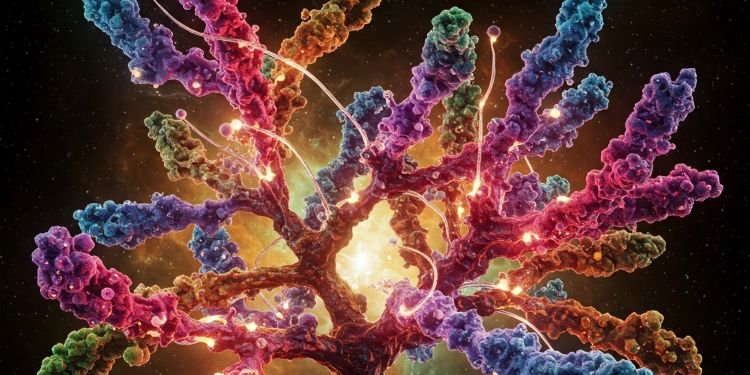Cause and effect in the many worlds of quantum physics

02/05/2025
Quantum physics, according to the many worlds interpretation, tells us that reality is made up of countless different physical universes, with different histories playing out in each universe. What room does this leave for cause and effect? In this blog post, Professor Alastair Wilson presents a new perspective on this issue.
The many worlds interpretation of quantum theory is one of the most astonishing and counter-intuitive ideas in contemporary theoretical physics. Humans might have thought it was already fairly surprising to find out that we inhabit just one continent of many, on one planet of many, in one solar system of many, in one spiral galaxy of many, in one galaxy cluster of many. The many worlds interpretation takes that progressively expanding vision of reality to a whole other level, adding to it the idea that we inhabit just one universe of many – in fact, that there is a distinct universe for every fractionally-different way that history could have turned out. Everything that physically can happen, physically does happen.
Many worlds raise many tricky philosophical puzzles. In recent decades, philosophers of physics have made sustained progress on these puzzles, achieving a better understanding of how to understand physical probability, empirical evidence, and the nature of matter in a many-worlds setting. A significant problem that remains unresolved is how cause and effect work in the many worlds interpretation. An upcoming collection of essays edited by Alyssa Ney (LMU Munich) explores all aspects of causality in many worlds. My contribution to that collection argues that causality is something which happens within quantum worlds, not something that happens to quantum worlds.
The problem with cause and effect in many-worlds quantum theory boils down to a tension between two ideas. First, the essential idea that the universes are isolated from one another, so that things we do in one universe can’t affect people in another universe – and the other universes can never be directly observed. Second, the widespread idea that the universes are constantly splitting, so that new universes are generated by the splitting of existing universes. The tension between these ideas is sharpened by the theory of relativity, which tells us that causal influences cannot travel faster than the speed of light. How then can any single quantum measurement instantly cause an entire universe to split – including distant galaxies – as the many worlds interpretation seems to suggest? Several different solutions have been proposed to address this basic tension.
One approach, the so-called ‘local branching’ approach, says that universes don’t split all at once. Rather, universes split in a rapidly growing wave – an ‘effective’ collapse of the quantum wavefunction – which expands outwards at the speed of light. Then, when I make a measurement in a lab on Earth, distant galaxies do not split until the physical influence of my measurement spreads out to meet them. That means that cause and effect can still respect the limit of the speed of light after all.
Another approach, the ‘global branching’ approach, says that universes do split all at once. Some defenders of global branching accept instantaneous causation, violating relativity’s constraints, but argue that since this causation can’t be controlled it’s acceptable. Other defenders of global branching reject instantaneous causation, so that my measurement doesn’t affect distant galaxies. The distant galaxy, they say, doesn’t change in itself when I make a measurement – it just becomes located in two universes rather than in one.
All of these approaches have their peculiarities, and in my essay for the volume I suggest a different line that defenders of many worlds can take. Instead of splitting worlds, we can appeal to the related but distinct metaphor of intertwined parallel worlds. My measurement doesn’t split the universe in two – there were two universes all along. Causality isn’t something which connects the different universes at all – it’s something which happens entirely within individual universes. And it is fully compatible with the relativistic constraint – no causal influence travels faster than light.
If we can’t explain the existence and features of the different quantum universes in terms of cause and effect, how can we explain them? Here, I have a novel suggestion: we should explain them metaphysically, rather than causally, in terms of the underlying quantum reality which transcends all the worlds. Here’s a metaphor which may help to illustrate the proposal. Consider the different pieces of a jigsaw puzzle. Each piece in a completed puzzle has a shape which exactly matches the shape of its neighbouring pieces – surely no coincidence! Yet, it would be a mistake to think that the shape of any piece causes the shape of the piece next to it. All their shapes are instead explained all at once by the pattern-printing machinery. In the same way, the underlying laws of quantum physics might explain the whole structure of quantum universes all at once, without need for there to be a causal process of world-splitting. Causal explanation is always explanation in the world, not explanation of the world.
Professor Alastair Wilson is Professor of Philosophy at the University of Leeds’ School of Philosophy, Religion and History of Science and Senior Adjunct Research Fellow at Monash University. He is interested in the nature of reality, broadly construed - including especially chance, explanation, and the relationship between physics and metaphysics. In The Nature of Contingency: Quantum Physics as Modal Realism (Oxford University Press, 2020) he defends a systematic metaphysical theory according to which the alternative possibilities studied by philosophers are grounded in the many worlds of quantum physics. In Modal Naturalism: Science and the Modal Facts (Cambridge University Press, 2024 – with Amanda Bryant) he defends the view that science is our best guide to possibility and necessity.

